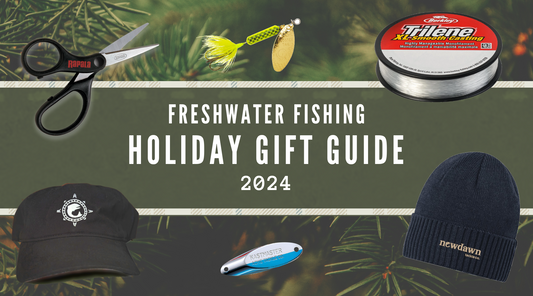
A Complete Beginner's Guide to Building a Tackle Collection
Neil ColicchioShare
So you’ve selected a rod and reel, and you’re feeling confident fishing with a live bait or two. What’s next on the path to building a more complete tackle collection? In this guide, I’ll explain a few different considerations to help you determine the best lures, terminal tackle, and accessories for the fish species in your local waters and the conditions you’ll encounter.
Researching Local Fish and Forage Species
The first step in expanding your tackle collection is to research the fish species and their forage in your local waters. Knowing what fish are present and what they are eating will help you choose the gear that most closely matches the hatch.
Identifying Fish Species
Here’s how to find out what fish are swimming nearby:
- Local Fishing Reports: Check online fishing reports and forums for updates on what species are currently active in your area. If you’re fishing a popular spot, you might even find a dedicated Facebook group for anglers fishing that body of water.
- Fish and Wildlife Agencies: Visit your state or local fish and wildlife agency’s website for information on local fish species, stocking reports, and fishing regulations. This is especially useful if you’re searching for stocked fish, like rainbow and brown trout, in much of New England.
- Local Bait and Tackle Shops: Talk to staff at local bait and tackle shops. They often have up-to-date knowledge about the best spots and what fish are biting. They may even share specific recommendations on lures or rigs that are working well in current conditions.
Understanding Forage Species
Forage species are the natural food sources that your target fish feed on. Knowing what forage is present will help you choose lures that mimic these food items.
Here are a few tips to help you learn what forage species are in your waters:
- Observe the Environment: Look for signs of baitfish, insects, and other small aquatic creatures in the water. Do you see ripples on the surface? Movement in the lilypads? Is there anything darting around in the shallows or seeking cover under the nearest dock?
- Use Local Knowledge: Ask local anglers or bait shop staff about common forage species in the area. If you’ve found a local fishing report or a community of local anglers, chances are you’ll soon learn what the fish are after. Sometimes, it’s a topic of debate among fellow anglers, so proceed with caution.
- Research Seasonal Changes: Weather patterns, water levels, and temperatures will fluctuate throughout the year. With these changes, the menu of local prey items will change. Consider the season, the current water temperatures, the weather within a day or two of your trip, and the conditions on the day of.
Common forage species include:
- Baitfish: Minnows, shad, bluegill, yellow perch, and other small fish
- Insects: Mayflies, caddisflies, and other aquatic insects
- Worms and Larvae: Earthworms, maggots, grubs, and caterpillars
- Crustaceans: Crayfish and shrimp
- Amphibians: Frogs, salamanders, and tadpoles
Understanding Fish and Prey Behaviors
The behavior of the prey and the predator are both important considerations when selecting a lure. If the water is hot and oxygen levels are low, the fish may be slower to pursue a fast-moving food item like a shad. They might be hiding under cover or in dense vegetation, which should be a sign to select a lure that you can work slowly with a hook placement that’s less prone to snagging.
This could be an opportunity to work some magic with a jig, but you might do just as well mimicking a damselfly on the surface. Some days, you might find success by mimicking the action around you - fishing topwater if the fish are rising, for example. On other days, your best bet is to fish the lures that you can work most confidently.
Here are some options that mimic a variety of prey items:
- Baitfish Imitation: Use lures like crankbaits, swimbaits, and spinners to mimic the movement of small baitfish. This is particularly effective in open water or near structures where baitfish congregate.
- Insect Imitation: Insects are a significant food source for many fish, especially during hatches. Small jigs or topwater lures can be used to mimic insects. This is ideal for streams, rivers, and the surface of lakes.
- Crustacean Imitation: Many fish love crayfish and shrimp. Jigs, soft plastic craws, and other bottom-bouncing lures work well for this. These are effective near rocky areas, weed beds, and river bottoms.
- Amphibian Imitation: Frogs and tadpoles are common prey for larger fish. Topwater frogs and soft plastic amphibians are great for this, especially in weedy or lily pad-filled waters.
Considering Your Approach to the Water
The way that you access the water can inform your tackle selection as well. Mobility, water depth, clearance, and casting distance all play a role in choosing the most effective tackle.
- Shore Fishing: Requires gear that’s easy to transport and cast from the bank. Consider longer rods to increase casting distance.
- Watercraft Fishing: Whether you’re in a boat, kayak, or canoe, you have more mobility and can access deeper waters, allowing for a broader range of tackle.
- Wading: Light and compact gear is essential for maneuverability. Wading also offers a unique way to get close to fish in streams and rivers.
- Other Options: Pier fishing, ice fishing, or fishing from docks may require specialized equipment.
Choosing the Right Lures
If you’ve done your research before hitting the water, you should have a general idea of what you’ll be targeting and where you’ll find the best chance of success. Now, all that’s left is to hone in on techniques and gear that will be the best match for your fishing conditions. You might consider a few of the following options to select the most suitable lures for your needs.
- Purpose: Mimic baitfish and cover a lot of water.
- When to Use: Great for active fish and covering large areas quickly.
- Techniques: Cast along shorelines, structures, and weed beds or troll in open water.
- Water Depth: Choose shallow diving for shallows and deep diving for deep water.
- Purpose: Attract fish with flash and vibration.
- When to Use: Effective in murky water or when fish are aggressive.
- Techniques: Cast along banks, towards ledges, or around vegetation.
- Water Depth: Versatile, suitable for both shallow and moderate depths.
- Purpose: Versatile baits that can be used to create many different movements depending on rigging and retrieval.
- When to Use: Suitable for a variety of fishing techniques, including Texas rig, Carolina rig, and drop shot.
- Techniques: Excellent for penetrating thick cover or when used on a jig or drop shot in deeper areas.
- Water Depth: Adaptable to any depth with appropriate rigging.
- Purpose: Create surface commotion to attract fish.
- When to Use: Best during low light conditions like dawn and dusk.
- Techniques: Cast parallel to shorelines, over shallow flats, or towards visible surface activity.
- Water Depth: Primarily for shallow water use.
Essential Accessories
If you’ve already been fishing with live bait, you’ll have a selection of terminal tackle available. With these tips, you can start to introduce new lures and techniques that will get you into the strike zone.
I’ve shared my top non-lure items on episodes 4 and 5 of my podcast, The Cottage Chronicles. I hope you’ll listen to the show for a more complete list, but here are a few highlights and extras to consider in the meantime.
Pliers and Line Cutters
These are useful for cutting lines, removing hooks (from fish and anglers alike), and making adjustments to your lures. Pliers are a must-have for crimping barbs on new hooks.
Check out my tools and accessories category for affordable pliers, forceps, and line cutters that will stand the test of time.
Landing Net
This is an excellent option for hauling big bass into a boat or for keeping fish in the water while you grab a quick picture. I don’t currently have landing nets for sale, but look for one with a bit of length in the handle and a rubberized net to avoid damaging the fish.
Measuring Tools
If you’re in search of a new personal best, scales and measuring tapes are critical.
What’s next?
This framework will ensure that you have a varied selection of tackle and a strong foundation in how to apply your fishing gear. It will also help you to assess the gaps or the weak points in your tackle tray. Suppose you choose to fish in the same area and the same species over time. In that case, you can upgrade to better quality, additional patterns, or even upgrade hooks, split rings, and features on your existing lures. If you choose to search for new species and fish new waters, you can go through the same matrix of questions to supplement your existing tackle with additional options.
- My Fishing Tips and Tutorials blog is a great starting point for exploring additional techniques and gear. I’ve got posts on lure selection, scouting new spots, and more.
- Keep an eye on the Newly Added category to learn about new tools, tackle, and accessories that I’m offering through New Dawn Tackle Co.
- Tune into The Cottage Chronicles each month for updates on my business, fishing tales, and behind-the-scenes content.
- Follow me on Instagram and Facebook to see what I’m fishing and what I’ve got my eyes on.
If you need guidance on the best tackle for your needs, whether it’s something I sell or not, you can reach me on social media any time or contact me here on the site. I wish you nothing but joy and success in all your fishing endeavors. If this post inspires you to get out there, tight lines, and happy fishing!
Neil Colicchio
Owner, New Dawn Tackle Co.



